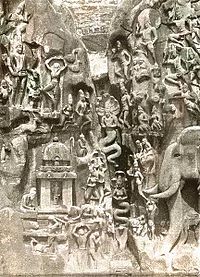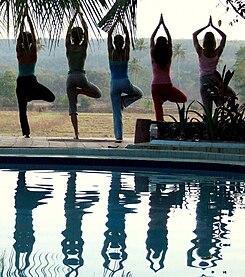Vriksasana

Vrikshasana (Sanskrit: वृक्षासन, romanized: vṛkṣāsana) or Tree Pose[1] is a balancing asana. It is one of the very few standing poses in medieval hatha yoga, and remains popular in modern yoga as exercise.[2]
Etymology and origins[]
The name comes from the Sanskrit words vṛkṣa (वृक्ष) meaning "tree",[3] and āsana (आसन) meaning "posture".[4]
A 7th-century stone carving in Mahabalipuram appears to contain a figure standing on one leg, perhaps indicating that a pose similar to vrikshasana was in use at that time. It is said that sadhus disciplined themselves by choosing to meditate in the pose.[5]
The pose is described in the 17th century Gheraṇḍa Saṃhitā 2.36. More recently it has been called iconic of modern yoga as exercise; it is often featured in yoga magazines, and practised in public displays such as for the International Day of Yoga.[6][7][8]

The Indian Minister of State for Home Affairs, Kiren Rijiju, in a public yoga session on the 3rd International Day of Yoga in Gangtok, Sikkim, 21 June 2017

A yoga display on the flight deck of USS George H.W. Bush, using Vrikshasana and Natarajasana, 2014
Description[]
From Tadasana, weight is shifted to one leg, for example, starting with the left leg. The entire sole of the foot remains in contact with the floor. The right knee is bent and the right foot placed on the left inner thigh, or in half lotus position. In either foot placement, the hips should be open, with the bent knee pointing towards the side. With the toes of the right foot pointing directly down, the left foot, center of the pelvis, shoulders and head are all vertically aligned. Hands are typically held above the head either pointed directly upwards and unclasped, or clasped together in anjali mudra. The asana is typically held for 20 to 60 seconds, returning to tadasana while exhaling, then repeating standing on the opposite leg.[9]
Variations[]
In Bikram Yoga, Tree Pose (called "Tadasana" in Bikram Yoga) is a slightly different standing posture, with one leg folded in Padmasana and the hands together over the chest in prayer position. It is followed by bending the straight leg into a squatting position (called Toe Stand or "Padangustasana" in Bikram Yoga) with the heel raised and the thigh resting on the calf and heel, the other leg remaining in (half) Padmasana.[10]

Rock relief seems to show Vrikshasana at top left.[5]

A group practising outdoors

Variant with one leg in Padmasana
See also[]
References[]
- ^ "Tree Pose". Yoga Journal. Retrieved 27 January 2019.
- ^ Iyengar 1979, p. 62.
- ^ "Urdhva Vrikshasana - AshtangaYoga.info". Retrieved 2011-04-11.
- ^ Sinha, S. C. (1 June 1996). Dictionary of Philosophy. Anmol Publications. p. 18. ISBN 978-81-7041-293-9.
- ^ a b Krucoff, Carol (28 August 2007). "Find Your Roots in Tree Pose". Yoga Journal.
- ^ Mulcahy, Matt. "Tree Pose (Vrksasana)". Om Yoga & Lifestyle Magazine. Retrieved 19 December 2021.
An iconic standing balance that draws its roots from hatha yoga, tree pose remains popular in modern practice and offers an exploration of hip-opening capacity.
- ^ Budig, Kathryn (11 December 2012). "How to Do a Yoga Tree Pose". Women's Health Magazine. Retrieved 19 December 2021.
It’s an iconic posture that symbolizes balance and harmony.
- ^ Kristlova, Eva (14 June 2020). "Quick Standing Sequence". Yoga Alliance. Retrieved 19 December 2021.
From here we enter one of the most iconic yoga poses – Tree Pose.
- ^ Mehta 1990, p. 21.
- ^ "The 26 Bikram Hot Yoga Postures". Sadhana Yoga & Wellbeing. Retrieved 9 May 2019.
Sources[]
- Iyengar, B.K.S. (1979). Light on Yoga (Revised ed.). Schocken Books. ISBN 978-0-8052-1031-6.
- Mehta, Silva; Mehta, Mira; Mehta, Shyam (1990). Yoga: The Iyengar Way. Dorling Kindersley.
- Standing asanas
- Medieval Hatha Yoga asanas
- Asymmetric asanas







